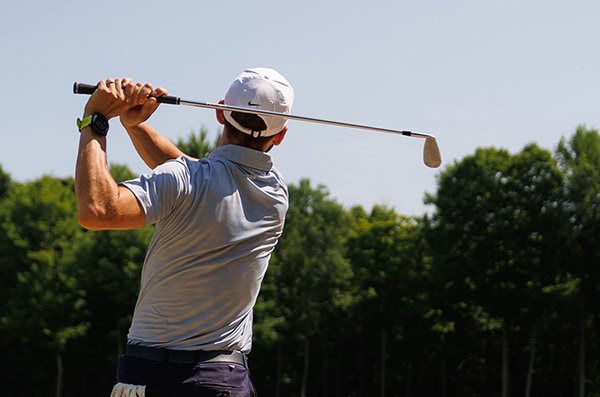-
{{link.label}}{{link.label}}
How Does Bounce Work on Wedges?
On this page
Most people will know about the different loft angles of wedges out there and how they can prove to be useful depending on the shot you need. However, it’s not only about the loft when it comes to wedges. You also have to consider the bounce.
Having the right bounce on your wedges is essential when you’re faced with tight lies. Yet, so many questions remain in the mind of golfers when it comes to bounce. Lucky for them, we’ve got it covered as we’ll be looking at the following questions:
- What is the bounce?
- How does bounce work?
- Are bounces the same for every brand?
- Does my swing affect the bounce I need?
- Do I need to adjust my bounce depending on the course?
What is the bounce?
The bounce of a club refers to the angle between a wedge’s sole and its leading edge. For example, when you’re in a position to hit your sand wedge, you’ll notice the leading edge of your club is not flush with the ground. The gap between the ground and your leading edge is the bounce angle of your club.
You can usually find the bounce degree indicated on the sole of your wedge, right next to the loft angle. This may change depending on the brand as some will show the bounce on the back of the club's face or even on the hosel of the club.
These bounce numbers are usually separated into three distinct categories:
- Low bounce with degrees usually sitting between 0 and 8 degrees;
- Mid or standard bounce, which is usually between 9 and 12 degrees;
- High bounce will cover anything above the 12-degree mark.
While these numbers may vary, as shown on the right, the scale listed above mentions bounce degrees that are more common for retail.
How does bounce work?
You might have guessed it from the name, but the bounce degree refers to the amount of bounce your wedge will have on the ground before coming into contact with the ball.
This means that the smaller bounce numbers will tend to dig into the ground and the bigger numbers will bounce or even glide across the turf. This is due to wedges with a bigger bounce having a larger sole than most.
Simply put, you’ll want to be able to use low-bounce wedges when you’re faced with tight lies or a firm surface. On the other hand, you’ll need the higher bounce when you’re playing on a softer surface, or even in the sand.
You’ll mostly find lower bounces on wedges with stronger loft angles like a pitching wedge or a gap wedge, which usually have loft angles sitting between 48 and 54 degrees.
The bigger soles of the bigger bounces will pay off on softer surfaces as you’ll be able to glide your clubs along the ground before hitting the ball. These clubs are especially great if you tend to hit down on the ball at a steep angle rather than sweep it.
Are bounces the same for every brand?

Yes, a 10-degree bounce for TaylorMade will be the same with Cobra, Callaway, Titleist, or even Ping. They might not all be displayed at the same place on the club, like in the case of Cobra and Mizuno. The former shows it on the hosel of the wedges and the latter in the back of the clubface, next to the loft.
But the same bounce degree doesn’t mean the clubs will play the same. You also have to take into account the grind of these wedges.
The grind refers to the form of your wedge’s sole. Titleist and its Vokey wedges have a very detailed list of lettered grinds to go along with their various bounce options. The F grind will fit most golfers as it can be used with bounces from as low as 8 degrees and as high as 14 degrees. For sweepers who like low-bounce wedges, the L grind is the one for you.
What type of bounce should I go for?

The bounce you end up with when choosing your wedges will greatly depend on the angle of attack of your swing with a wedge in hand. Think about it in terms of divots.
Deep divots
If you’re the type of player who digs trenches in the ground with your wedges, a higher bounce will fit you better. Your divot pattern is a product of steep swing and the higher bounce degree will allow your wedge to bounce off the ground instead of digging in it.
Small divots
If you’re more the type of player to make smaller divots you might be looking for the mid to low range bounce. They’re versatile and they’ll be there to help you out in case of a bad swing. Plus, the bounce will help out just enough to avoid your wedge from digging into the ground before making contact.
No divots
If you’re not making any other damages to the ground aside from clipping a few strains of grass, then you’re a sweeper and you’ll want something with a low bounce. The lowest bounce degrees will allow you to fit the leading edge of your wedge between the golf ball and the grass to pick the ball clean off the ground.
Shop All Our TaylorMade Wedges
Do I need to adjust my bounce depending on the course?
The courses you’re playing on will also have a role in your decisions regarding bounce. Dry and hard courses, similar to Links golf, are easier to play when you’re using low-bounce wedges. The hard grounds make it difficult for you to dig in with your wedge shots, which is why the low bounce will allow you to get right under the ball.
As for softer courses, think of courses near croplands, the wider soles of high bounce wedges will help you make contact with the ball while saving you from digging up trenches in the grounds of the course.
Some experienced players will be able to use a low bounce wedge on such a course, but for the vast majority of golfers, going with the safer alternative of the high bounce will save you a world of trouble.
Whichever style of bounce you end up going with for your wedges, keep in mind that you’ll need to try them out before heading on to the course with them. You’ll want to have a good feel for the type of shots you’ll be able to produce with your new bounce.
Finally, we do share extra wedge tips, but there is one final parting tip for you. Don’t be shy to mix in a lower bounce in your set for your gap wedge. You’ll rarely if ever, hit chip shots with this wedge, but a lower bounce (say a 10-degree if the rest of your wedges are 12 and up) will come in handy from time to time in tight lies.
Until next time,
The Golf Avenue Team
Further reading
Hitting the right wedge shot at the right time can make all the difference on your scorecard. Learn how to use them in the right situation.
You love TaylorMade golf wedges but you don't know which one is best for you? We've got your covered with this top 5!




_20231006191450_0.jpg)

